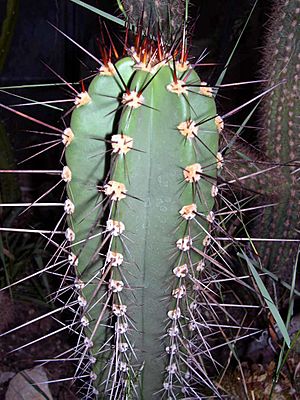Neoraimondia herzogiana facts for kids
Quick facts for kids Neoraimondia herzogiana |
|
|---|---|
 |
|
| Scientific classification | |
| Genus: |
Neoraimondia
|
| Species: |
herzogiana
|
| Synonyms | |
|
|
Neoraimondia herzogiana is a unique tree-like cactus that grows naturally in Bolivia. It belongs to the Cactaceae family, which includes all cacti. This plant is known for its tall, sturdy trunk and branches, making it look more like a tree than a typical cactus.
Contents
Discovering the Neoraimondia Cactus
Neoraimondia herzogiana was first officially described in 1967. It was named after Theodor Herzog, a botanist who explored the plant life of Bolivia. This cactus is a fascinating example of how plants adapt to tough environments.
What Does It Look Like?
This cactus can grow very tall, sometimes reaching up to 15 meters (about 50 feet) high! It has a thick, woody trunk that helps it stand strong. The branches are covered in ribs, which are like vertical ridges, and these ribs have clusters of sharp spines. These spines protect the cactus from animals that might try to eat it.
The stems of Neoraimondia herzogiana are usually a greenish-blue color. They are quite thick, often about 20 to 30 centimeters (8 to 12 inches) across. The spines can be long and strong, making the plant look quite imposing.
Where Does It Grow?
Neoraimondia herzogiana is native to specific dry regions of Bolivia. It thrives in arid (dry) and semi-arid areas, often found on rocky slopes or in valleys. These areas usually have very little rainfall and can get very hot during the day.
The cactus is well-suited to its environment. It can store water in its thick stems, allowing it to survive long periods without rain. Its deep root system helps it find water far underground.
How Does It Survive in Dry Lands?
Cacti like Neoraimondia herzogiana have special ways to live in deserts. Their thick, waxy skin helps to reduce water loss. The spines also help by creating a small shaded area around the stem, which keeps the plant cooler.
Most cacti open their stomata (tiny pores for breathing) only at night. This helps them take in carbon dioxide when it's cooler, losing less water through evaporation. This process is called CAM photosynthesis.
Flowers and Fruits
Like many cacti, Neoraimondia herzogiana produces beautiful flowers. These flowers typically bloom during certain times of the year, often after a period of rain. The flowers can be white or pinkish and usually open at night.
After the flowers are pollinated, they develop into fruits. The fruits are often round or oval and can be red or yellow when ripe. They contain many small seeds. These fruits are a food source for some animals in its habitat.
Importance and Conservation
This tall cactus is an important part of the ecosystem in Bolivia. It provides shelter and food for various desert animals. Its unique appearance also makes it interesting to botanists and plant lovers.
While Neoraimondia herzogiana is not currently listed as endangered, protecting its natural habitat is important. This ensures that future generations can continue to admire this amazing tree-like cactus.
See also
 In Spanish: Neoraimondia herzogiana para niños
In Spanish: Neoraimondia herzogiana para niños

